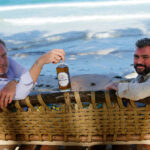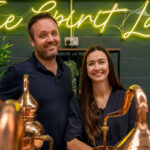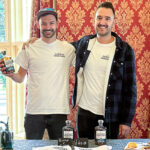Co-founders, Rolling Fork Spirits: TURNER WATHEN & JORDAN MORRIS
Turner Wathen and Jordan Morris founded Rolling Fork Spirits in 2017 with a mission to bring unique rums to the U.S. market. Through hand-selected cask aging and blending, they craft rums that adhere to their motto: no finer spirits can be made.
Introduced by their spouses in 2013, Morris and Wathen quickly established that they were both interested in distilled spirits, and they both agreed that premium rum was a non-existent offering in the U.S. market. After the meeting, the two decided to buck the American whiskey trend for independent bottlers and pursue their joint passion for fine rum.
They both grew up in Kentucky, so Kentucky bourbon was the starting point for their dive into the world of distilled spirits. In fact, Wathen is a direct descendant of the famous Wathen Kentucky bourbon distilling family. The Wathen family’s first distillery, the Rolling Fork Distillery (established in 1788) was the inspiration for the brand name.
Let’s learn more about them in this interview:
TRL: What does rum mean to you? What made you fall in love with rum and when did it happen?
Rum is a spirit with a lot of history. As with all history, there’s some good and some bad. However, the ongoing story of rum has shaped lives, economies, and world history. So, when you drink a rum – whether it is a pure pot still, high-ester rum from Jamaica or an Agricole from Martinique – you are drinking this accumulation of know-how and skill specific to that region, distillery, and producer. Once you embrace that aspect of rum, you start to truly appreciate the different styles and flavor profiles that can be achieved.
Rum tells stories. It’s a huge part of the culture in so many places. It allows different countries to express themselves and reach new audiences–and become a part of your own community. For us, we truly appreciate the opportunity to work with all these different styles of rum, and we can add a little of our own story to the history of rum.
TRL: Three essential characteristics that define rum according to your perspective.
We keep it pretty simple: fermentation, distillation, and aging. Of course, each one of those things sends you down a rabbit hole of options. Styles of rum have a subset of options in each category, and every rum distillery has its own unique combination.
Since we’re talking to the Rum Lab (rather than trying to explain rum to whiskey drinkers), we won’t do the deep dive. However, in fermentation, of course, there’s the base material (molasses, fresh cane juice, evaporated cane juice, etc), the yeast profile (wild yeast, cultivated yeast, etc.), and other factors (cane vinegar, back-set/dunder, etc.). Distillation is more than just pot-still, column, or hybrid, but those are the big buckets.
Finally, there is aging (which, in talking with rum producers, doesn’t yet get as much attention as the other parts of the process) and that is where we have control – and it is growing in interest. Since we’re based in the bourbon capital, we’re quite granular in how we view aging. Most rum producers view a bourbon cask as a bourbon cask, regardless of the details of that bourbon cask. We take a different view. We believe the place and the source of the American oak are important, as is the cooperage, the char level and toast profile, and the profile of the bourbon that was previously in the cask. These are all factors that will affect the rum that we put into that cask.
TRL: What is the most important contribution you have made to the rum industry?
When we first started, we thought our biggest contribution would be our ability to bottle and sell rare rums in the U.S. And we’ve certainly bottled some exciting rums, including a 1998 Guadeloupe Bellevue rum and a 1998 Barbados Foursquare distilled rum.
For us though, as we’ve built our strategy, which is a bit different than a pure independent bottler, we’ve built our knowledge and product offerings around our cask aging knowledge, particularly when it comes to American whiskey casks.
We were the first bottler to pay close attention to detail on the specific bourbon cask when bottling a rum. For example, our wheated bourbon cask-aged rum has become quite popular because drinkers have come to appreciate the pastry notes and light baking spice flavors that that type of cask imparts on rum. We had a group of well-known rum industry veterans visit our facility and taste our different cask types. It finally dawned on us that we were passing on knowledge to a group of people we respected when they started asking us questions about the different cask characteristics – because they noticed the flavor differences.
So, we believe our most important contribution, when we look back in 10 or 20 years, will be our deep-dive into the characteristics of bourbon casks or rye whiskey casks and how those characteristics affect the flavor profile of the rum aging in that cask.
TRL: Benefits that the rum industry has given you.
It’s all about relationships with distillers, growers, and spirits enthusiasts.
Through our adventure in the spirits industry, we’ve had the good fortune to meet many people that we truly admire. The secret of this industry is that distilled spirits are a universal language. We’ve been in places where not a word was understood between either party, but somehow, a meeting of the minds was accomplished over a pleasant drink.
TRL: What’s another thing you are passionate about besides rum? Why?
Well-made spirits. Being from Kentucky, perhaps our blood is some percentage of bourbon. However, we also believe that U.S. spirits enthusiasts who are passionate about American whiskey can be just as passionate about any well-made spirit. Options just haven’t been available in the U.S.
So, while we love fine rum and think that it isn’t yet well represented in the U.S., we are just as fascinated and captivated by other distilled spirits that are made with passion and care: Japanese whiskey, Scotch, the French holy trinity (Armagnac, Calvados, and Cognac), gin, and any other spirit that elicits that “wow” moment when you take your first drink.
TRL: What is your favorite place for drinking rum?
We’re supporters and customers of any good rum bar. There’s a “we’re all in this together attitude” for rum producers and rum bars. We know that we’re still in the education period for rum, where spirits enthusiasts are still absorbing information and understanding what rum really is. One of our personal favorites, because of the care they take in promoting and educating on rum, is Smuggler’s Cove in San Francisco.
TRL: Favorite drink + Recipe
We love sipping rum neat, or perhaps with a cube, but we also love a Hemingway Daiquiri. Grapefruit and rum all day long!
Jordan is a bizarre person and likes to make a Boulevardier riff using 0.75 oz of Kentucky bourbon and 0.7 5oz of Rolling Fork Rum distilled in Barbados. By bumping up the sweeter notes of the powerful spirit in the drink with the rum, the Campari is a touch more balanced.
TRL: Why is it important to educate the rum consumer?
Rum is misunderstood by most U.S. consumers. Because there are not a lot of options in the U.S. for fine rum (but it is definitely growing), many consumers will try one or two readily available rums and decide that they don’t like rum as a category. So, we believe it is important to educate rum consumers so that they understand that there are many styles of rum.
Many U.S. consumers view rum as an island cocktail while on vacation. But, rum has so much more to offer! There is a groundswell of interest and information–with sites like The Rum Lab who are telling the stories and educating people. We feel lucky to be on this journey with rum.
TRL: Any tips to train the palate and taste a good premium rum?
The first thing we tell people is that not every rum is for every person. It is completely okay to try a “premium rum” and decide that it is not your thing. We tell people all the time to seek variety, seek information. Once you find some rums you like, seek good rum information sources to identify other rums of a similar style.
We also recommend, in a more practical sense, trying your rum at different proofs (you can always add water; just do it slowly with a water dropper to your glass). You’ll start to notice different flavors develop and other flavors diminish with the addition of water. You may not like a rum with bottle strength, and you may love that same rum with the addition of water. Don’t be afraid to experiment.
TRL: How can the rum contribute to improving the crisis in some countries?
Rum has a growth trajectory. The challenge is that, at a country and local level, political systems have to design incentives that flow to the local economy and rum producers. We’re just two guys from Kentucky, so we honestly don’t know how to plan that strategy.
TRL: Who would you like to meet in the rum industry? What would you say to him/her?
We love to meet producers that put passion and care into the products they make. These are the producers that make the rums that we age, blend, and bottle. Top of the list would be the team at Foursquare Distillery.
TRL: What are your next goals in the rum industry?
Change people’s perceptions about rum!
TRL: Why is the role of the bartender important in the rum industry?
Bartenders are often a consumer’s first information source about a specific spirit. So, knowledgeable bartenders are the primary educators for interested spirits enthusiasts.
TRL: What is your advice for new generations in the rum industry?
We’d like to think we’re still new in the rum industry. However, when we started, there were few others in the rum industry in the U.S. So, the advice we would pass on is to be curious and seek information. Rum is a diverse spirit with a long history. Fortunately, there are great resources now available online and in print.
TRL: How can people learn more about you? Website? Social media page?
About The Author
Creative Director for EmpresasFH and Director of HOFFMANNdesign. Born and raised in Caracas, Venezuela, Mr. Hoffmann has been one of the most important designers for prestigious companies in South America, including Disney, Cartoon Network, Mattel among others.





